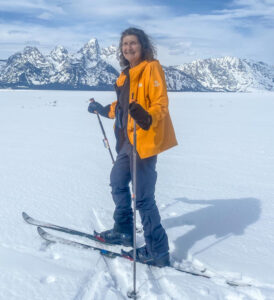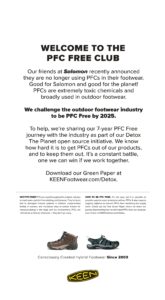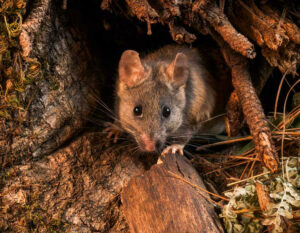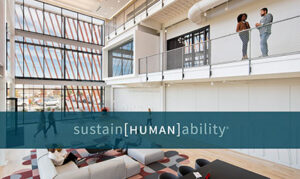March 2021 Newsletter: Vaccines, Vacation, and Videos
Hello!
|
I’m grateful that after receiving both COVID vaccinations, I was able to enjoy my annual March birthday ski trip. For two happy weeks, I cross country skied, watched wildlife and appreciated the majestic beauty of the Grand Tetons mountains. With the vaccine roll-out going smoothly, I hope we can all stay healthy and return to the activities we love very soon. For my next trip, I’m planning a dive refresher in Cozumel. Get in touch if you might like to join me. In the meantime, our Institute is conducting meetings virtually, and we’re finding that some work especially well this way. For example, we just piloted our two-session Science and Communication Strategy Workshop for more than two dozen scientists from all over the world on Zoom. The workshop—a great success—had more diverse participants and a much smaller carbon footprint than if it had been in person. It was easy to record videos of the talks here so others could learn our strategy for translating scientific research into positive change. And this Monday on World Water Day, the Keen shoe company, with whom we work for healthier outdoor shoes and gear, issued a challenge to the outdoor industry. In a full-page ad in the New York Times, they shared their journey to PFAS free products and links to a detailed roadmap so other companies could follow more quickly with less cost. It is indeed time for the outdoor industry to move away from PFAS and we are hoping other companies will follow Keen. Please consider watching All In: The Fight for Democracy, a documentary about voter suppression. The film masterfully interweaves our country’s dark history of disenfranchisement with the story of Stacey Abrams, whose gubernatorial run was undermined by it. Another important effort for us is reducing the use of toxic materials in the building industry. Our recent commentary in Environmental Science & Technology explains that a flame retardant commonly used in foam insulation for “green buildings” may break down into harmful chemicals that end up in people and ecosystems. It received international media coverage, including in the widely syndicated UPI, the French science news outlet Futura, and the Australian magazine Cosmos. For updates on my daughter Annalise’s current work on environmental security, you can check out her website. She is also a Lecturer in Environmental Sciences and Policy at Johns Hopkins University and was honored to be selected for a Shawn Brimley Next Generation National Security Leaders Fellowship. With warm regards and optimism that 2021 will be a much better year than 2020, |
What Made the Large Mysterious Structures in the Woods?Walking familiar trails in Tilden Park, a friend pointed out mysterious large structures woven of branches. Some were as large six feet by six feet and we could not imagine what could’ve made them. No beavers in the area. Yetis? The answer is the very industrious and cute California dusky-footed wood rat. Please read on for short excerpts from Michael Ellis’s great article about these small nocturnal creatures in Bay Nature and consider signing up for a subscription to support this informative publication for outdoors-lovers. Woodrats are sometimes called pack rats because they love to collect and store various kinds of junk… Folks living near these critters have reported missing shoes, lace curtains, crackers, soap, wallpaper, and even gum wrappers. A woodrat nest may look like an enormous haphazard pile of sticks and leaves from the outside, but inside is a carefully designed and organized forest home. Like us humans, woodrats have very particular requirements for their homes. Not too dry or too wet… Goldilocks with whiskers! |
Watch Now: Science and Communication Strategy for ChangeOver the last decade, we have helped change government policy and business purchasing to protect human and environmental health from toxic chemicals. These successes have been based on our unique strategy for communicating scientific research. Indeed, four of the top 20 most-read articles in ES&T Letters were co-authored by our Institute. We want to share our strategy with other scientists who study harmful chemicals. Toward that goal, we developed a free two-session online workshop that we piloted earlier this month. Scientists and communications experts shared inspirational stories and practical advice to increase the impact of scientific research. Now you can watch those talks below. Also, you can download helpful resources from our website, including a communications plan, including a communications plan worksheet and press release template. Day 1 Talks– Impactful Science
Science + Communication + Decision Makers = Positive Change
Rachel Carson’s Legacy: Connecting Science to Policy
Science and Communication for Change Day 2 Talks– Strategic Communication
Making Your Science Newsworthy
Communicating Science through the Media
Improving Scientific Story-telling If you find the talks useful, please pass them on to your networks. Here are posts on Twitter, LinkedIn, and Facebook to share. |
Green Science Policy Institute Honored as Sustainability LeaderOur Institute is proud to receive a leadership award from Shaw Industries for our work supporting “the wellbeing of people and the planet amid the unprecedented challenges of 2020.” The award is part of Shaw’s sustain[HUMAN]ability® Leadership Recognition Program. Shaw, one of the world’s largest carpet manufacturers, has participated in our industry workshops and retreats focused on finding innovative solutions to reduce the use of the Six Classes. Their engagement with us was critical in getting the carpet industry to move away from PFAS. “The sustain[HUMAN]ability® Leadership Awards strive to recognize others who share our commitment to putting people at the heart of sustainability,” says Kellie Ballew, vice president of global sustainability at Shaw. “By spotlighting a wide range of organizations, we aim to inspire others — small businesses, large corporations, entrepreneurs, academia, nonprofits, governments and more regardless of industry — to drive change.” |
Could PFAS Reduce the Effectiveness of Your COVID-19 Vaccination?By Hannah Ray
PFAS chemicals such as PFOA and PFOS are known to be associated with a wide variety of health problems. Could PFAS exposure also reduce the effectiveness of COVID-19 vaccinations? To answer this important question, the U.S. Centers for Disease Control and Prevention is conducting a study of healthcare workers and first responders looking for correlations between PFAS levels and antibody response to the coronavirus. Certain PFAS are known to impact the human immune system. This includes associations with decreased resistance to infections and cancer and increased autoimmune disease incidence. So it’s not surprising that past studies found that PFAS exposure could reduce the effectiveness of vaccines for diphtheria and tetanus, rubella and mumps, and influenza. However, the mechanisms of immune system suppression are not well understood, nor is it possible to predict how different types of PFAS in the body might interact with specific vaccines. A recent study by Philippe Grandjean at Harvard found correlation between elevated blood levels of a short-chain PFAS, called PFBA, to more severe courses of COVID-19 infections. Given what is already known about PFAS and the immune system, as the new COVID-19 vaccines begin to be distributed worldwide, it makes good sense to monitor vaccine responses in populations with high PFAS exposure. Their potential to reduce the efficacy of vaccinations is yet another reason to limit the unnecessary use of PFAS chemicals. |
Flame Retardant-Free ClimbingBy Tom Bruton
What do gymnastics and rock climbing have in common? Participants in both sports like to push their limits, and they rely on foam padding to break their falls. Previous research has found that gymnasts have above average levels of the flame retardant pentaBDE in their blood, and higher levels of this harmful chemical on their hands after practice than before. The likely explanation is that pentaBDE was added as a flame retardant to the polyurethane foam used to safely cushion falls in gyms. Indoor rock climbing gyms are wildly popular here in the Bay Area (at least, prior to the pandemic), and we wondered whether their wall-to-wall foam padding could also be a source of exposure to harmful flame retardants. To find out, we collected samples from foam pads at four local climbing gyms and sent them for testing at the Duke University Foam Project. We also sent samples of foam from two portable climbing crash pads. The results? Eight of our nine samples did not contain any of the flame retardants that Duke tests for. One sample came back positive for the flame retardant chlorinated Tris or TDCPP. While our sample size was small, these results suggest that climbing pads do not (or no longer) commonly contain flame retardants. Good news for all of us who enjoy clinging to the side of a crag! |
CalendarApril 22, 2021: Living Future 21 When: 1:30 P.M. – 2:30 P.M. PST Arlene Blum will join a panel at the ILFI Living Furniture 21 meeting entitled “Transforming the Material Supply Chain: From the Lab Bench to the Job Site.” 2:45 P.M. – 3:45 P.M. PST Tom Bruton and Seth Rojello Fernández of our Institute will give a talk at the ILFI Living Future 21 meeting. The title of their talk is: “Tracking Down Forever Chemicals in Building Products and Seeking Healthier Alternatives.”
Goldman Environmental Prize Award Ceremony The Goldman Environmental Prize is the “Nobel prize for environmental work” honoring grassroots activists from the six continents. Usually this moving event can only be viewed by a limited number of ticket holders–our favorite event of the year! The last inspirational event was a beautiful and moving livestream hosted by Sigourney Weaver. Please do take a break and enjoy it here. |






